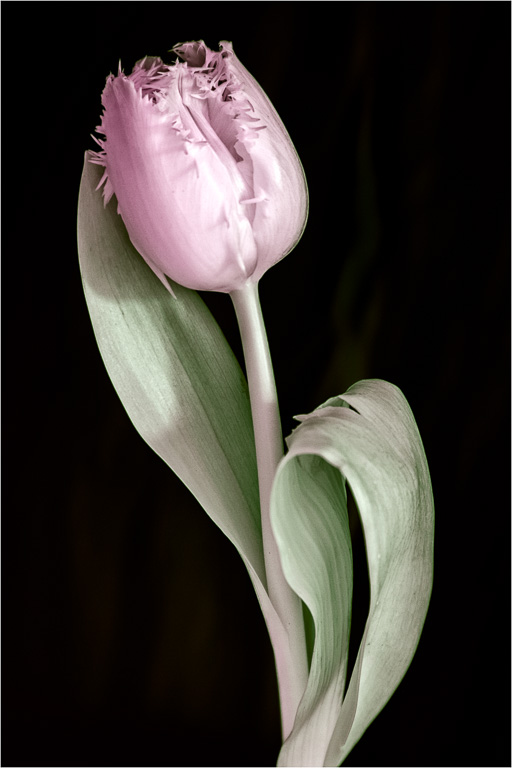Shot of the Week 2019/08 – Salute
There are many positives to undertaking a challenge which requires the regular production of images. Not least is the incentive to use the camera. Life has plenty of other distractions and it is all too easy not to take a photograph for a while. Another benefit such a project is the opportunity to try different styles of photography. A couple of weeks ago I was doing just that when shooting a tulip past its sell-by date in infrared against a black background. I like to photograph a variety of subjects, but that particular shot got me thinking about other possibilities. There was definitely scope for further experimentation in a personal project which has no rules about repetition.

The shooting set-up this time was similar but I chose a tulip which was definitely in its prime. At least, I hope so as I had bought it earlier that day. I again shot with my infrared camera but used a different lens. One which is marketed on the basis that it is not very good. Or rather, that its optical defects introduce an ethereal quality to images taken with it. In other words, character is a more important attribute than absolute sharpness in its rendering.
The Lens
The lens? It is Lomography’s Daguerreotype Achromat 64 f/2.9 Art Lens to give its full title and a reinvention of the world’s first photographic optic lens. The original was created in the 19th century by Charles Chevalier for the Daguerreotype camera. Optically, both versions are alike in that the design consists of two lens elements in a single group. The modern update has features which were not present in the original. It is conceivable, for example, that the Chevalier lens did not have an internal focussing mechanism. What I can be certain about is that dating to 1839, it did not come with a choice of mounts such as the Canon EF fitting on my copy.
It also seems that the first lens came with a fixed f/4 aperture. The Lomography reinvention uses Waterhouse stops to change the aperture. These are plates with circular holes which are inserted into the lens barrel. Granted that it is not as convenient as an aperture ring but this is a manual focus objective and operation is not going to be quick. Besides, although capable of serious work, in some ways the Daguerreotype lens is a novelty. The Waterhouse stops add to its appeal.
It is possible that my description of the Chevalier lens is not entirely accurate. I have done some research on the Internet but details are frustratingly vague. The most informative article which I have found is from Lomography, although it is not as comprehensive as I would like.
The Photograph
Wide open, the Daguerreotype lens produces a very ethereal looking image. Stopped down, it becomes surprisingly sharp despite the simplistic optical design. Wide open at f/2.9, it can be very soft. At f/4 some of that softness is reamins but already it is appreciably sharpening up. This shot was taken at f/5.6 which is the limit for retaining any of the len’s characteristics.
Focussing proved to be a challenge. My infrared camera is a modified Canon EOS 450D and usually I rely on autofocus. Focusing using the viewfinder on a DSLR is difficult as it lacks the necessary aids which were abundant in the days of manual focus. Fortunately, the camera has live view but in infrared everything looked grey. Added to that, a soft focus lens does not provide much detail to determine easily the exact point of focus. I found it best to use one of the smaller stops to get the clarity I required and magnify the image. f/5.6 worked well and once I was confident of the focus I could switch to a larger aperture if I wanted that option.
Colour is our eye’s response to different wavelengths of light in the visible spectrum and it follows that colour cannot exist in infrared. A digital camera is still recording in colour and some hues will be apparent in the image. This provides an opportunity to introduce false colour effects during post processing. The colours of my tulip shot are not dissimilar to how it looked although that is a coincidence. Other flowers with different colouration which I photographed at the same time turned out similarly with the same processing applied.
The final change was to flip the image for a stronger composition. It looks as though the flower is saluting, hence the title. I know, I have anthropomorphised a tulip of all things.
Narcissus
To give a better idea of how the Daguerreotype lens performs at its maximum aperture, I took this shot with lens wide open. Again, I used my infrared camera. In reality, the flowers were white and yellow, not pink as seen here.
